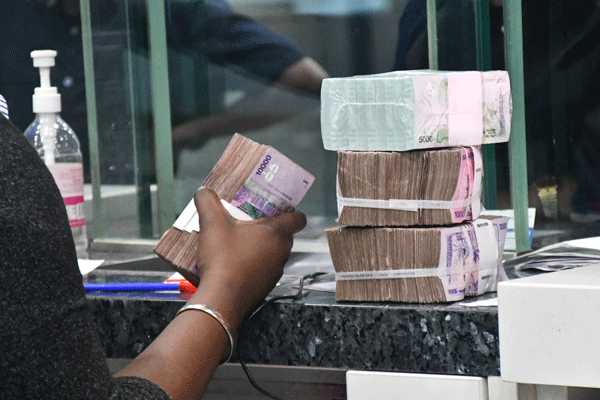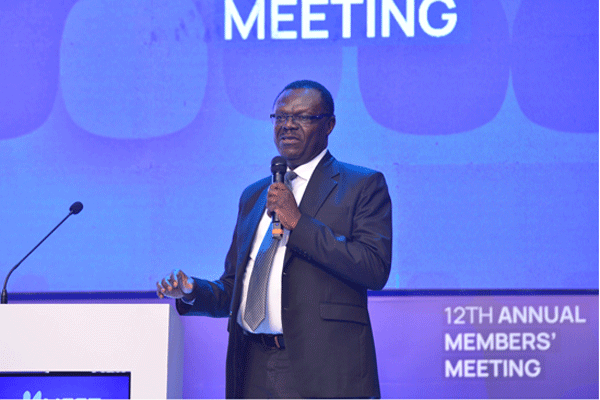
NSSF savers listen to the presentation during the 12th Annual Members' meeting on September 26. PHOTO/ISAAC KASAMANI
Ever wondered how the National Social Security Fund (NSSF) works its magic to turn your contributions into a thriving nest egg?
As Uganda’s national pension fund, NSSF is like the ultimate financial player in your corner, but the game is not as simple as it seems.
Its managers are always in boardrooms looking at all sorts of graphs, reading a bunch of economics books, scratching heads, and exchanging ideas as they strategise on how to maximise every shilling deposited by savers.
The Fund selects its investment assets through a strategic process that balances risk and returns while adhering to a regulatory framework set by the Finance Ministry and the Financial Sector Conduct Authority.
Its investment strategy emphasizes diversification across various asset classes, including government securities such as bonds and treasury bills, equities in publicly listed companies, real estate, fixed deposits, infrastructure projects, and, to a lesser extent, private equity and venture capital.
But before investing, NSSF conducts thorough due diligence, assessing potential returns, liquidity, and alignment with national development goals.
How did it do that last year?
The Fund leveraged on increased member contributions which increased by 12.2 percent from Shs1.72 trillion in the 2022/2023 financial year to Shs1.93 trillion in the 2023/2024 financial year to invest in different asset classes in the bond market, stock market and real estate.
This, in addition to the assets the assets they have garnered that reached Shs22.12 trillion, a 19.2 percent increase compared to the previous year, allowed it to spread the investments to get a return by the close of the year.
Ultimately, reduced cost of administration, and high net incomes offset the losses in the few non-performing assets that it had.
Its earnings surged by 15 percent in the financial year that ended on June 30, 2024 from Shs2.2 trillion to Shs2.53 trillion. Most of this income came from an increase in interest income earnings, dividend income as well as real estate income, which all increased.
Equities
When comparing the increases in percentages in income avenues, dividend income increased the most with a 20.61 increase to Shs175 billion which suggests that the companies in which NSSF is invested either improved their profitability, leading to higher dividend pay-outs.
The stock market rose during the year across the regional markets in Kenya, Uganda, Dar-es-Salaam and Rwanda, with a positive net foreign investor inflow across.
The Fund tactically added MTN and Airtel, two value stocks to its stock portfolios, which boosted its investment diversification strategy as well as returns. Some of these stocks were gotten at juicy discounts.
“We made a big investment in MTN and another one in Airtel. Airtel was an initial public offering and it was a secondary issuance for MTN. The dividends MTN gave us in the year were Shs40.5 billion compared to the prior Shs30 billion. Airtel gave us almost Shs22 billion in dividends. There are a couple of other counters that gave us good dividends like Equity Bank (Shs19 billion), Safaricom (Shs19 billion), Tanzania Breweries Limited (Shs10 billion). Dividend income did well but so is the recovery of the equity markets,” said Gerald Paul Kasaato, NSSF’s deputy managing director.
“When you compare, the exchange rate recovered this year in our favour to the extent that we made Shs255 billion in exchange gains alone. When you amalgamate our equity positions, year on year, the fair value gain on equities was over Shs300 billion. So when you put all that, it explains our increase in income and assets,” he explained.
But these investments mostly on the local exchange have fumed scrutiny over the liquidity problem the bourse has because when NSSF buys stock in a local company, it is over 40 percent of the issued shares and hit 80 percent when Airtel was on its initial public offering last November.
NSSF says that timing is one of its strategies when buying stock in a company. It targets value stocks especially in the Ugandan market because the liquidity is low and the lowest in the East African region.
In Kenya today, you can have a liquidity of $1.5 million (Shs5.5 billion) but before Covid-19, that liquidity used to be even more than $10 million (Shs36.9 billion) daily.
By contrast, the Uganda Securities Exchange (USE) hardly has even $5,000 (Shs18.5 million) a day. There are rules on market making which the Capital Markets Authority has but this is what bothers NSSF because it not certain where its qualified to be a market maker or not.
“We are having discussions with USE to see how we can play the role of a market maker. The question is whether a pension fund can actually do money making because that is normally done by broker dealers but if we consult and we are told that that is something we can do, that is one of the interventions we can take. There are also conversations on securities lending which requires a tweak of the regulations in terms of making our securities available to people who can sell them and give us a commission but these are discussions that are actually happening,” said Mr Kasaato.
Interest income
This was followed by the 17 percent increase in the interest income. Is the money from NSSF investments made mostly in the bond market? The outlier here is Kenya whose bond yields upped the most even though others in Uganda and Kenya increased as well. The bond market in Kenya showed positive momentum with rising prices and the Kenyan shilling also appreciated, something that increased the Fund’s revenue in unrealised income.
The growth in interest income, experts note, indicates that NSSF has managed its fixed-income investments. But it may also suggest that the returns from these investments are more predictable and less volatile than equities. This is essential for maintaining liquidity and meeting member withdrawal demands.
“The implication of that is that the bulk of our investments are at around 79 percent and we take advantage of that and lock in some good rates because if you lock in a 20-year bond, that means you can get a sustainable return for our members,” said Mr Patrick Ayota, NSSF’s managing director.
This is a good rate for investors in the bond market and funds that have to secure a huge chunk of their money in safe havens such as the bonds where returns are certain and payment is guaranteed by the sovereign.
But this has also kept Uganda’s balance of payments in a current account deficit, which according to economic books, means there needs to be a surplus on the capital accounts, so that money has to come from abroad.
As an institutional investor, the Fund plays a crucial role by purchasing government bonds during new issuances, thereby providing essential capital to the government.
“Today, you would struggle to get an auction fully subscribed without the Fund’s participation. Without our intervention, probably the outcome would have been worse in terms of the interest rate situation,” Mr Ayota said.
Real estate projects
Investments in real estate made the smallest increase in revenue generation compared to what dividends and fixed income brought in. Real estate income increased by 11.76 percent to Shs13.3 billion.
This could be due to various factors such as market conditions affecting property values, occupancy rates, or rental yields. While real estate provides more stability, it may not have experienced the same momentum as equities, especially in a buoyant market.
The Fund’s Pension Towers currently stand at about 82 percent to completion. The Fund had hoped that it would have been completed by the close of this year “but unfortunately we can't. We are looking at the project being completed next year,” Mr Kasaato said.
“The other big projects like Temangalo is at 41 percent construction. The Mbale project is at 75 percent, the Yusuf Lule project is still at the design stage. We hope that the design will be completed and approved by the local authorities, and we will start construction in this financial year. Lubowa is no longer a project, we are now selling. We have received almost Shs7 billion in cash deposits and we have over 76 out of the 306 units to the market which is over 30 percent,” said Mr Kasaato.
“Our analysis shows that although it was not without challenges, across East Africa, it was a better year compared to the 2022/2023 financial year. The Ugandan economy recovered and recorded a 6 percent growth in Gross Domestic Product (GDP), inflation remained under control, regional stock markets recovered and the interest rates slightly increased,” said Mr Ayota.
During the period, the Uganda shilling appreciated across all currencies except the Kenyan shilling which appreciated more.
The Fund follows the strategic long term asset allocation that is informed by the liability structure, target return and risk considerations.
As of June 30, 2024, 79.2 of its assets were in fixed income, 13.1 percent in equities and 7.7 percent in real estate.
Its funds under management increased by 19.2 percent from Shs18.56 trillion in the 2022/2023 financial year to Shs22.13 trillion in the 2023/2024 financial year. This marks the highest level they have reached, reflecting a steady increase over the past five years.
If you follow the money, it tells a story. Contributions from members have risen in the last five years, averaging Shs1.4 trillion to the point at which they rose by 12.2 percent to Shs1.93 trillion last fiscal year.
After all valuations, the Fund’s total realised earnings increased by 15 percent to Shs2.53 percent during the period from Shs2.2 trillion, about Shs300 billion more, which consists of interest income, dividends and rental income
Current compliance stands at 57 percent, which may explain why contributions are lower than the projections made by pundits.
The Fund’s cost-to-income ratio or how much it spent out of each shilling it raised in revenues went up slightly by 0.11 percent to 8.77 percent.
“If you look at the banking industry – it is a wrong comparison because we are not a bank. But it is the closest you can come to a bank. The average cost-to-income ratio is around 60 percent, which means that for each Shs100 they get in revenue, they spend Shs60 in costs. That is because of the efficiencies we have built around the Fund with time,” said Mr Ayota.
The Fund pays out this money when you hit 50 and you are no longer employed or even when you are 45 through midterm access.
These benefits paid have slightly reduced from Shs1.199 trillion to Shs1.120 trillion during the period in what management says is related to the confidence members have in the fund to grow their fortune.
The reduction was driven by a drop in the number of people who claimed benefits which reduced from 48,115 people to 44,250 people.
This performance cheers the Finance ministry, which is the Fund’s overseer. And this is what that the National Treasury considers to decide what interest its savers should get each year.
Other factors include the financial stability and growth of the Fund, whether it is investing in the right assets and sectors of the economy and whether the Fund is preserving and growing the value of members’ savings.
The Fund achieved commendable performance across most key performance indicators from total assets, realised income, cost of administration, and contributions all surpassed their budgeted expectations, something that forced its assets to grow to Shs20 trillion by January 2024, reaching this target nearly 18 months ahead of the expected date of 30 June 2025.
Kenyan financial markets
One outlier is the Kenyan financial markets. The Fund’s income surged tremendously due to good performance in the bond market in both Uganda and Kenya – the appreciation of the Kenyan shilling which increased the money NSSF gets from interest in many of the instruments it invests in.


